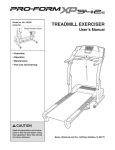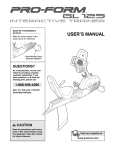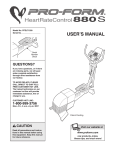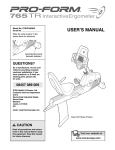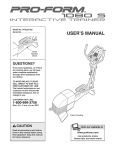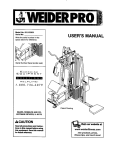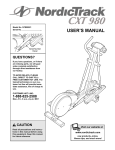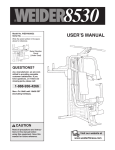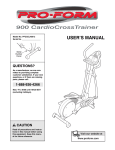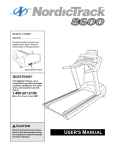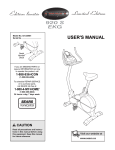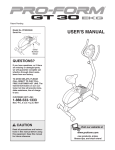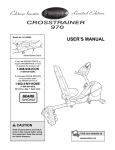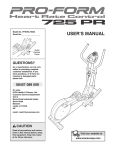Download USER`S MANUAL - Pdfstream.manualsonline.com
Transcript
USER’S MANUAL Model No. HRE59020 Serial No. Serial Number Decal QUESTIONS? If you have questions, or if there are missing parts, we will guarantee complete satisfaction through direct assistance from our factory. TO AVOID DELAYS, PLEASE CALL DIRECT TO OUR TOLLFREE CUSTOMER HOT LINE. The trained technicians on our customer hot line will provide immediate assistance, free of charge to you. CUSTOMER HOT LINE: 1-800-999-3756 Mon.–Fri., 6 a.m.–6 p.m. MST CAUTION Read all precautions and instructions in this manual before using this equipment. Keep this manual for future reference. Visit our website at www.healthrider.com new products, prizes, fitness tips, and much more! TABLE OF CONTENTS IMPORTANT PRECAUTIONS . . . . . . . . . . . . . . . . . . . . . . . . . . . . . . . . . . . . . . . . . . . . . . . . . . . . . . . . . . . . .3 BEFORE YOU BEGIN . . . . . . . . . . . . . . . . . . . . . . . . . . . . . . . . . . . . . . . . . . . . . . . . . . . . . . . . . . . . . . . . . . .4 ASSEMBLY . . . . . . . . . . . . . . . . . . . . . . . . . . . . . . . . . . . . . . . . . . . . . . . . . . . . . . . . . . . . . . . . . . . . . . . . . . .5 HOW TO USE THE ELLIPTICAL CROSSTRAINER . . . . . . . . . . . . . . . . . . . . . . . . . . . . . . . . . . . . . . . . . . . . .9 MAINTENANCE AND TROUBLESHOOTING . . . . . . . . . . . . . . . . . . . . . . . . . . . . . . . . . . . . . . . . . . . . . . . . .20 CONDITIONING GUIDELINES . . . . . . . . . . . . . . . . . . . . . . . . . . . . . . . . . . . . . . . . . . . . . . . . . . . . . . . . . . . .21 PART LIST . . . . . . . . . . . . . . . . . . . . . . . . . . . . . . . . . . . . . . . . . . . . . . . . . . . . . . . . . . . . . . . . . . . . . . . . . . .22 EXPLODED DRAWING . . . . . . . . . . . . . . . . . . . . . . . . . . . . . . . . . . . . . . . . . . . . . . . . . . . . . . . . . . . . . . . . .23 HOW TO ORDER REPLACEMENT PARTS . . . . . . . . . . . . . . . . . . . . . . . . . . . . . . . . . . . . . . . . . . .Back Cover LIMITED WARRANTY . . . . . . . . . . . . . . . . . . . . . . . . . . . . . . . . . . . . . . . . . . . . . . . . . . . . . . . . . . .Back Cover HealthRider is a registered trademark of ICON Health & Fitness, Inc. 2 IMPORTANT PRECAUTIONS WARNING: To reduce the risk of serious injury, read the following important precautions before using the elliptical crosstrainer. 1. Read all instructions in this manual before using the elliptical crosstrainer. 8. Always hold the handgrip pulse sensor or the handlebars when mounting, dismounting, or using the elliptical crosstrainer. 2. It is the responsibility of the owner to ensure that all users of the elliptical crosstrainer are adequately informed of all precautions. 9. The pulse sensor is not a medical device. Various factors may affect the accuracy of heart rate readings. The pulse sensor is intended only as an exercise aid in determining heart rate trends in general. 3. Place the elliptical crosstrainer on a level surface, with a mat beneath it to protect the floor or carpet. Keep the elliptical crosstrainer indoors, away from moisture and dust. 10. Keep your back straight when using the elliptical crosstrainer; do not arch your back. 4. Inspect and properly tighten all parts regularly. Replace any worn parts immediately. 11. If you feel pain or dizziness at any time while exercising, stop immediately and begin cooling down. 5. Keep children under 12 and pets away from the elliptical crosstrainer at all times. 12. When you stop exercising, allow the pedals to slowly come to a stop. 6. The elliptical crosstrainer should not be used by persons weighing more than 250 pounds. 13. The elliptical crosstrainer is intended for home use only. Do not use the elliptical crosstrainer in a commercial, rental, or institutional setting. 7. Wear appropriate exercise clothing when using the elliptical crosstrainer. Always wear athletic shoes for foot protection. WARNING: Before beginning this or any exercise program, consult your physician. This is especially important for persons over the age of 35 or persons with pre-existing health problems. Read all instructions before using. ICON assumes no responsibility for personal injury or property damage sustained by or through the use of this product. 3 BEFORE YOU BEGIN Congratulations for selecting the new HealthRider® C840E elliptical crosstrainer. The C840E elliptical crosstrainer is an incredibly smooth exerciser that moves your feet in a natural elliptical path, minimizing the impact on your knees and ankles. And the unique C840E features adjustable resistance and a state-ofthe-art console to help you get the most from your exercise. Welcome to a whole new world of natural, elliptical-motion exercise from HealthRider. questions after reading this manual, call our Customer Service Department toll-free at 1-800-999-3756, Monday through Friday, 6 a.m. until 6 p.m. Mountain Time (excluding holidays). To help us assist you, please note the product model number and serial number before calling. The model number is HRE59020. The serial number can be found on a decal attached to the elliptical crosstrainer (see the front cover of this manual for the location). For your benefit, read this manual carefully before you use the elliptical crosstrainer. If you have Before reading further, please familiarize yourself with the parts that are labeled in the drawing below. Water Bottle Holder* Bookrack Console Pulse Sensor Handlebar FRONT Pedal Arm Wheel BACK Pedal Pedal Disk Pedal Leg LEFT SIDE *No water bottle is included 4 ASSEMBLY Assembly requires two persons. Place all parts of the elliptical crosstrainer in a cleared area and remove the packing materials. Do not dispose of the packing materials until assembly is completed. In addition to the included allen wrenches, assembly requires a phillips screwdriver , an adjustable wrench , and a rubber mallet . As you assemble the elliptical crosstrainer, use the drawings below to identify the small parts used in assembly. The number in parenthesis below each drawing refers to the key number of the part, from the PART LIST on page 22. The second number refers to the quantity used in assembly. Note: Some small parts may have been pre-assembled for shipping. If a part is not in the parts bag, check to see if it has been pre-assembled. M8 Nylon Locknut (38)–4 M4 x 16mm Screw (52)–2 M10 Nylon Locknut (33)–4 M6 x 20mm Pedal Screw (63)–4 M10 Split Washer (59)–6 M6 x 25mm Screw (7)–1 M8 x 19mm Button Screw (56)–2 Plastic Washer (77)–4 M10 Bolt Set (74)–2 M8 x 45mm Button Bolt (50)–4 M10 x 27mm Patch Screw (40)–2 M10 Bracket Washer (35)–2 Handlebar Washer (55)–2 M10 x 27mm Button Screw (67)–6 M10 x 75mm Carriage Bolt (34)–4 1. Identify the Front Stabilizer (10), which has Wheels (22) attached to it. While another person lifts the front of the Frame (1), attach the Front Stabilizer to the Frame with two M10 x 75mm Carriage Bolts (34) and two M10 Nylon Locknuts (33). Make sure that the Front Stabilizer is turned so the Wheels are not touching the floor. 1 22 34 22 1 34 10 5 33 2. While another person lifts the back of the Frame (1), attach the Rear Stabilizer (9) to the Frame with two M10 x 75mm Carriage Bolts (34) and two M10 Nylon Locknuts (33). 2 33 9 33 1 34 3. While another person holds the Upright (2) in the position shown, connect the Extension Wire Harness (44) to the Wire Harness (28). Carefully pull the upper end of the Extension Wire Harness to remove any slack. While holding the upper end of the Extension Wire Harness, insert the Upright into the Frame (1). Do not pinch the Wire Harnesses. 3 67 Turn the Upright Knob (43) counterclockwise several turns. Next, pull the Upright Knob, slide the Upright (2) down until the Knob is aligned with one of the adjustment holes, and then release the Knob. Do not tighten the Knob yet. 59 2 Adjustment Holes Feed the upper end of the Extension Wire Harness (44) through the Upright Extension (73). Attach the Upright Extension to the Upright (2) with three M10 x 27mm Button Screws (67) and three M10 Split Washers (59). 4. Connect the wire harness on the Handgrip Pulse Sensor (29) to the indicated wire harness on the Console (23). Insert both wire harnesses into the opening in the bottom of the Console. Next, insert the metal tube on the Handgrip Pulse Sensor into the opening in the bottom of the Console. Be careful not to pinch the wire harnesses. Make sure the Wire Harnesses 73 (44, 28) do not get pinched and damaged during 59 this step. 67 44 1 44 28 43 4 23 52 23 Bracket Metal Tube Refer to the inset drawing. Align the holes in the bracket on the Console (23) with the holes in the metal tube on the Handgrip Pulse Sensor (29). Tighten two M4 x 16mm Screws (52) through the bracket into the tube as shown. 52 Tube 29 Wire Harnesses 5. The Console (23) requires four “D” batteries (not included); alkaline batteries are recommended. Press the tab on the battery cover, and lift off the battery cover. Insert four batteries into the battery compartment. Make sure that the batteries are oriented as shown by the diagram inside the battery compartment. Reattach the battery cover. 5 Battery Cover Tab Batteries 23 6 29 6. While another person holds the Console (23) in the position shown, connect the wire harness on the Console to the Extension Wire Harness (44). Insert the excess wire harness into the Upright Extension (73). 6 Bookrack 23 Attach the Console (23) to the Upright Extension (73) with three M10 x 27mm Button Screws (67) and three M10 Split Washers (59). Be careful to avoid pinching the wire harnesses. Wire Harness Snap the bookrack onto the Console (23) in the indicated location. 7. Identify the Left Handlebar (6), which is marked with a sticker. Insert the Left Handlebar into one of the Handlebar Arms (5); make sure that the Handlebar Arm is turned so the hexagonal holes are on the indicated side. Attach the Left Handlebar to the Handlebar Arm with two M8 x 45mm Button Bolts (50) and two M8 Nylon Locknuts (38). Make sure that the Nylon Locknuts are inside of the hexagonal holes. Do not fully tighten the Button Bolts yet. 44 67 59 67 73 7 6 Make sure that there are two Small Handlebar Bushings (49) in the Left Handlebar (6). Carefully slide an Upright Spacer (48), a Handlebar Spacer (47), the Left Handlebar, and a Handlebar Cap (46) onto the left axle on the Upright (2) as shown. Slide a Handlebar Washer (55) onto an M8 x 19mm Button Screw (56), and tighten the Button Screw into the axle. 48 46 55 47 49 38 56 5 50 Assemble the Right Handlebar (8) and the other Handlebar Arm (5) in the same way. Hexagonal Holes 5 8 63 13 Attach the other Pedal (not shown) to the Right Pedal Arm (not shown) in the same way. Make sure that both Pedals are attached in the same position. 12 7 8 Grease Apply a small amount of the included grease to the left and right axles on the Upright (2). 8. Attach a Pedal (13) to the Left Pedal Arm (12) with two M6 x 20mm Pedal Screws (63) as shown. Note: The Pedal can be attached in any of three positions (see HOW TO ADJUST THE PEDALS AND THE UPRIGHT on page 9). 67 59 2 9. Apply a small amount of grease to the axle on the left Disc Crossbar (16). Slide the Left Pedal Leg (11) onto the axle. Slide an M10 Bracket Washer (35) onto an M10 x 27mm Patch Screw (40), and tighten the Patch Screw into the axle. 9 Grease Attach the Right Pedal Leg (not shown) to the right side of the elliptical crosstrainer in the same way. 16 11 10. Position a Cushion (70) in one of the adjustment holes in the Left Pedal Leg (11). Set the Left Pedal Arm (12) on the Cushion, with the end of the Pedal Arm inside of the angled bracket on the Pedal Leg. Slide a Plastic Washer (77) between the Pedal Arm and the Pedal Leg. Insert the long part of the M10 Bolt Set (74) through the Pedal Leg, Plastic Washer, and Pedal Arm. 40 35 7 5 10 2 Lift the Left Pedal Leg (11) and hold the left Handlebar Arm (5) inside of the bracket on the Left Pedal Arm (12). Slide the other Plastic Washer (77) between the Pedal Arm and the Pedal Leg. Insert the long part of the M10 Bolt Set (74) through the Handlebar Arm, Pedal Arm, Plastic Washer, and Pedal Leg. Tighten the short part of the Bolt Set into the long part. 43 5 12 77 77 Attach the Right Pedal Arm (not shown) to the Right Pedal Leg (not shown) and the right Handlebar Arm (5) in the same way. Tighten the M6 x 25mm Screw (7) into the Upright (2). Turn the Upright Knob (43) clockwise until it is tight. Refer to step 7. Tighten the M8 x 45mm Button Bolts (50 in the Handlebar Arms (5). 74 Grease 70 74 11 11. Make sure that all parts of the elliptical crosstrainer are properly tightened. Note: Some hardware may be left over after assembly is completed. To protect the floor or carpet from damage, place a mat under the elliptical crosstrainer. 8 HOW TO USE THE ELLIPTICAL CROSSTRAINER HOW TO ADJUST THE PEDALS AND THE UPRIGHT HOW TO EXERCISE ON THE ELLIPTICAL CROSSTRAINER The motion of the elliptical crosstrainer is determined by the positions of the pedals and the upright. Follow the instructions below to adjust the motion of the elliptical crosstrainer. To mount the elliptical crosstrainer, hold the Pulse pulse sensor Sensor and step onto the pedal that is in the lowest Pedals position. Then, step onto the other pedal. Push the pedals until they begin to move with a continuous motion. Note: The pedal disks Pedal Disk can turn in either direction. It is recommended that you move the pedal disks in the direction shown by the arrow; however, for variety, you may turn the pedal disks in the opposite direction. To adjust the pedals, first Upright Upright remove the pedal Knob screws. Slide the pedals to one of the three positions, and then reattach them with the screws. Make sure that the pedals are in the same posiCushion tion. In addition, adjust the cushPedal ions for the Screws Pedal desired feel; the position of the cushions affects pedal travel. Make sure that the cushions are in the same position. To dismount the elliptical crosstrainer, wait until the pedals come to a complete stop. Note: The elliptical crosstrainer does not have a free wheel; the pedals will continue to move until the flywheel stops. When the pedals are stationary, step off the highest pedal first. Then, step off the lowest pedal. To adjust the upright, first turn the upright knob counterclockwise a few turns to loosen it. Next, pull the knob, raise or lower the upright to the desired height, and then release the knob. Move the upright up and down slightly until the pin on the knob snaps into one of the four adjustment holes in the upright. Make sure that the upright is not resting on top of the pin. Then, turn the knob clockwise until it is tight. HOW TO MOVE THE ELLIPTICAL CROSSTRAINER Stand behind the elliptical crosstrainer, hold the rear Wheel stabilizer firmly, and lift the Rear elliptical Stabilizer crosstrainer until it can be moved on the front wheels. Carefully move the elliptical crosstrainer to the desired location and then lower it. CAUTION: To decrease the possibility of injury, bend your legs and keep your back straight as you lift the rear stabilizer; make sure to lift with your legs rather than your back. HOW TO USE THE HANDLEBARS The handlebars are designed to add upper-body exercise to your workouts. As you exercise, push and pull the handlebars to work your arms, shoulders, and back. To exercise only your lower body, hold the pulse sensor as you exercise. Handlebars Pulse Sensor 9 A B E C D F G K H J I FEATURES OF THE CONSOLE The advanced console offers a selection of features designed to make your workouts more enjoyable and effective. When the manual mode of the console is selected, the resistance of the elliptical crosstrainer can be adjusted with a touch of a button. As you exercise, the console will provide continuous exercise feedback. You can even measure your heart rate using the built-in handgrip pulse sensor. The console also offers six Smart workout programs. Each program automatically changes the resistance of the elliptical crosstrainer and prompts you to increase or decrease your pace as it guides you through an effective workout. In addition, the console features two Heart Rate workout programs that automatically change the resistance of the elliptical crosstrainer and prompt you to vary your pace to keep your heart rate near a target heart rate as you exercise. The console also features new iFIT.com interactive technology. IFIT.com technology is like having a personal trainer right in your home. Using a stereo audio cable (available at electronics stores), you can connect the elliptical crosstrainer to your home stereo, portable stereo, or computer and play special iFIT.com CD programs (CD’s are available separately). IFIT.com CD programs automatically control the resistance of the elliptical crosstrainer and prompt you to vary your pace as a personal trainer coaches you through every step of your workout. High-energy music provides added motivation. Each CD features two programs designed by certified personal trainers. In addition, you can connect the elliptical crosstrainer to your VCR and TV and play iFIT.com video programs (videocassettes are available separately). Video programs offer the same benefits as iFIT.com CD programs, but add the excitement of working out with a class and an instructor. With the elliptical crosstrainer connected to your computer, you can also go to our new Web site at www.iFIT.com and access audio programs and video programs directly from the internet. To purchase iFIT.com CD’s and videocassettes, call toll-free 1-800-735-0768. 10 CONSOLE DESCRIPTION is currently shown. Note: When the distance is shown, the word Miles or the letters Kms will appear; when your speed is shown, the letters MPH or Km/H will appear. Refer to the drawing on page 10. Note: If there is a thin sheet of clear plastic on the face of the console, remove it. F. Pace bar graphs—When the manual mode is selected, only the left bar graph will appear. This bar graph represents your exercise pace. As you increase or decrease your pace, additional bars will appear or disappear on the bar graph. When a Smart program, a Heart Rate program, or the iFIT.com mode is selected, both bar graphs will appear. The left bar graph represents your exercise pace, and the right bar graph represents a target pace. During the program, the target pace will periodically change. As the right bar graph changes, simply adjust your pace so that the same number of bars appear on both bar graphs. Important: The target pace is a goal pace. Your actual pace may be slower than the target pace, especially during the first few months of your exercise program. Make sure to exercise at a pace that is comfortable for you. A. Exercise feedback display—This display features seven modes that give you instant exercise feedback: your current speed, the elapsed time (or the time remaining in a Smart program or a Heart Rate program), the distance that you have pedaled, the resistance level, the approximate number of calories you have burned, the approximate number of fat calories you have burned (see FAT BURNING on page 21), and your heart rate (when you use the handgrip pulse sensor). If the scan mode is selected, the display will change from one mode to the next every six seconds. Or, you can select a single mode for continuous display. Note: The console can show speed and distance in either miles or kilometers. To change the unit of measurement, hold down the On/Reset button for six seconds. The mode indicators (see E below) will show which unit of measurement is selected. When the batteries are replaced, it may be necessary to reselect the desired unit of measurement. G. On/Reset button—When the console is off, pressing this button will turn on the display. When the console is on, pressing this button will reset the display. This button is also used to select the unit of measurement for speed and distance (see A at the left). B. Increase and decrease arrows—During Smart programs, Heart Rate programs, and iFIT.com programs, these arrows will prompt you to increase or decrease your pace to match the target pace. H. Display Mode button—This button is used to select the feedback modes. The modes will be selected in the following order: scan, speed, time, distance, resistance level, calories, fat calories, and heart rate (when the handgrip pulse sensor is used). C. Manual mode/program indicator—When a Smart program is selected, the upper right corner of the display will show a 1, 2, 3, 4, 5, or 6, depending on which Smart program is selected. When a Heart Rate program is selected, the upper right corner of the display will show a 7 or 8. When the iFIT.com mode is selected, the upper right corner will show the letters IF. When the manual mode is selected, the upper right corner will be blank. I. + and – buttons—These buttons control the resistance of the elliptical crosstrainer. There are ten resistance levels; level 10 is the most challenging. These buttons are also used to enter your age when a Heart Rate program is selected. J. Program button—This button is used to select the manual mode, Smart programs, and Heart Rate programs. D. Program profiles—These profiles show how the resistance of the elliptical crosstrainer and the target pace will change during Smart programs and Heart Rate programs. For example, profile number 3 shows that during Smart program 3, both the resistance and the pace will gradually increase during the first half of the program, and then gradually decrease during the last half. K. IFIT.com button—This button is used to select the iFIT.com mode. The indicator on the button will light when the iFIT.com mode is selected. To use the manual mode of the console, refer to page 12. To use a Smart program, refer to page 13. To use a Heart Rate program, refer to page 14. To use iFIT.com CD’s or videos, refer to page 18. To use a program directly from our Web site, refer to page 19. E. Feedback mode indicators—These indicators show which feedback mode (scan, speed, time, distance, resistance level, calories, fat calories, or heart rate) 11 time the resistance level changes, the console will show the resistance level for six seconds. In addition, when a Smart program or a Heart Rate program is selected, the display will show the time remaining in the program instead of the elapsed time. HOW TO USE THE MANUAL MODE 1 Turn on the console. Note: The console requires four “D” batteries (not included). If you have not installed batteries, refer to step 5 on page 5 and install batteries. In addition, the left bar graph will appear in the display to show your exercise pace. As you increase or decrease your pace, additional bars will appear or disappear on the bar graph. To turn on the console, press the On/Reset button or begin pedaling. 2 If desired, you can select a single feedback mode for continuous display. Press the Display Mode button repeatedly until only the MPH (or Km/H), Time, Miles (or Kms), Resist., Cals., or Fat Cals. indicator appears in the display. Make sure that the Scan indicator does not appear. Select the manual mode. Each time the This corner console is should be blank turned on, the manual mode will be selected. If a Smart program, a Heart Rate program, or the iFIT.com mode has been selected, select the manual mode by pressing the Program button repeatedly until the upper right corner of the display is blank. 3 5 Note: If there are thin sheets of plastic on the metal contacts on the handgrip pulse sensor, peel off the plastic. To use the handMetal grip pulse senContacts sor, place your hands on the metal contacts. Your palms must be on the upper contacts and your fingers must be touching the lower contacts. Avoid moving your hands. When your pulse is detected, the heart-shaped indicator in the display will flash each time your heart beats. After a moment, two dashes (– –) will appear and then your heart rate will be shown. Begin exercising and adjust the resistance of the elliptical crosstrainer. As you exercise, adjust the resistance of the elliptical crosstrainer as desired by pressing the + and – buttons. There are ten resistance levels; level 10 is the most challenging. Note: After the buttons are pressed, it will take a few seconds for the selected setting to be reached. 4 Measure your heart rate if desired. Follow your progress with the feedback modes and the left bar graph. When the console is turned on, the scan mode will be selected. As you exercise, the display will show your current speed, the elapsed time, the distance that you have pedaled, the current resistance level, the approximate number of calories you have burned, and the approximate number of fat calories you have burned. In addition, your heart rate will be shown when you use the handgrip pulse sensor (refer to step 5 on this page). Note: Each For the most accurate heart rate reading, continue to hold the handgrips for about 15 seconds. Note: When you first hold the handgrips, the display will show your heart rate continuously for 15 seconds. The display will then show your heart rate along with the other feedback modes. 6 When you are finished exercising, the console will automatically turn off. If the pedals are not moved and the console buttons are not pressed for a few minutes, the console will automatically turn off to conserve the batteries. 12 The pace settings for the program will be shown by the right bar graph in Increase Arrow the display. (The left bar graph will show your actual exercise pace.) As the right bar graph changes during the program, simply increase or decrease your pace so that the same number of bars appear on both bar graphs. If your pace is slower than the current pace setting, the increase arrow will appear in the display to prompt you to increase your pace; if your pace is faster than the pace setting, the decrease arrow will appear. Important: The pace settings for the program are intended only to provide a goal. Your actual pace may be slower than the pace settings, especially during the first few months of your exercise program. Make sure to exercise at a pace that is comfortable for you. HOW TO USE A SMART PROGRAM 1 Turn on the console. Refer to step 1 on page 12. 2 Select one of the six Smart programs. Each time the console is turned on, the manual mode will be selected. To select a Smart program, press the Program button repeatedly until the number 1, 2, 3, 4, 5, or 6 appears in the upper right corner of the display. The profiles numbered 1 through 6 on the left side of the console show the resistance and pace settings for the Smart programs. For example, profile number 3 shows that when Smart program 3 is selected, both the resistance and the pace will gradually increase during the first half of the program, and then decrease during the last half. 3 During the program, the display will show the time remaining in the program. When no time remains, the program will be completed. If you continue exercising after the program is completed, the display will continue to show your exercise feedback. Start the program. 4 To start the program, simply begin exercising. Each Smart program consists of either twenty or thirty, one-minute periods. One resistance setting and one pace setting are programmed for each period. (The same resistance setting and/or pace setting may be programmed for consecutive periods.) Follow your progress with the feedback modes. Refer to step 4 on page 12. 5 Measure your heart rate if desired. See step 5 on page 12. During the program, the resistance of the elliptical crosstrainer will automatically change as shown by the applicable profile on the console. If the current resistance level is too high or too low, you can change the resistance level by pressing the + and – buttons. However, when the current period of the program is completed, the resistance level will automatically change if a different resistance setting is programmed for the next period. 13 6 When you are finished exercising, the console will automatically turn off. Refer to step 6 on page 12. 4 HOW TO USE A HEART RATE PROGRAM When using a Heart Rate program, you must use the handgrip pulse sensor. It is not necessary to hold the handgrips continuously during the program. However, you should hold the handgrips frequently for the program to operate properly. Each time you hold the handgrips, keep your hands on the metal contacts for at least 30 seconds. Note: When you are not holding the handgrips, the letters PLS will appear in the display instead of your heart rate. Each Heart Rate program helps you to keep your heart rate near a certain percentage of your maximum heart rate during your workout. (Your maximum heart rate is estimated by subtracting your age from 220. For example, if you are 25 years old, your maximum heart rate is 195.) Heart Rate program 7 is designed to keep your heart rate between 65% and 85% of your maximum heart rate while you exercise; Heart Rate program 8 is designed to keep your heart rate between 65% and 80% of your maximum heart rate. 5 Follow the steps below to use a Heart Rate program. 1 Turn on the console. Select one of the two Heart Rate programs. Each time the console is turned on, the manual mode will be selected. To select a Heart Rate program, press the Program button repeatedly until the number 7 or 8 appears in the upper right corner of the display. The profiles numbered 7 and 8 on the right side of the console show the resistance settings for the Heart Rate programs. For example, profile number 7 shows that when Heart Rate program 7 is selected, the resistance level will gradually increase during the program and then decrease near the end. 3 Start the program. To start the program, simply begin exercising. Each Heart Rate program consists of twenty, oneminute periods. One resistance setting and one heart rate setting are programmed for each period. (The same resistance setting and/or heart rate setting may be programmed for consecutive periods.) Refer to step 1 on page 12. 2 Hold the handgrip pulse sensor. Enter your age. When a Heart Rate program is selected, the word AGE will appear in the display. You must enter your age to use a Heart Rate program. To enter your age, first press the + or – button. The current age setting will then be shown. Next, press the + or – button repeatedly to enter your age. Once you have entered your age, your age will be saved in memory until the batteries are replaced. 14 During the program, the resistance of the elliptical crosstrainer will automatically change as shown by the applicable profile on the console. If the current resistance level is too high or too low, you can adjust the resistance level by pressing the + and – buttons. However, when the current period of the program is completed, the resistance level will automatically change if a different resistance setting is programmed for the next period. As you exercise, the bar graphs will help you to keep your heart rate near the heart rate setting for the current period. The left bar graph will show your actual exercise pace. The right bar graph will show a target pace. When you hold the handgrip pulse sensor, the console will compare your heart rate to the heart rate setting for the current period. If necessary, the right bar graph will then change to prompt you to increase or decrease your pace to bring your heart rate closer to the current heart rate setting. When the right bar graph changes, increase or decrease your pace so that the same number of bars appear on both bar graphs. If your pace is slower than the current pace setting, the increase arrow will appear in the display; if your pace is faster than the pace setting, the decrease arrow will appear. Important: The pace settings for the program are intended only to provide a goal. Your actual pace may be slower than the pace settings, especially during the first few months of your exercise program. Make sure to exercise at a pace that is comfortable for you. HOW TO CONNECT YOUR CD PLAYER, VCR, OR COMPUTER To use iFIT.com CD’s, the elliptical crosstrainer must be connected to your portable CD player, portable stereo, home stereo, or computer with CD player. See pages 15 to 17 for connecting instructions. To use iFIT.com videocassettes, the elliptical crosstrainer must be connected to your VCR. See page 17 for connecting instructions. To use iFIT.com programs directly from our Web site, the elliptical crosstrainer must be connected to your home computer. See page 17 for connecting instructions. During the program, the display will show the time remaining in the program. When no time remains, the program will be completed. If you continue exercising after the program is completed, the display will continue to show your exercise feedback. 6 HOW TO CONNECT YOUR PORTABLE CD PLAYER Note: If your CD player has separate LINE OUT and PHONES jacks, see instruction A below. If your CD player has only one jack, see instruction B. Follow your progress with the feedback modes. A. Plug one end of a 1/8” to 1/8” stereo audio cable (available at electronics stores) into the jack beneath the console. Plug the other end of the cable into the LINE OUT jack on your CD player. Plug your headphones into the PHONES jack. Refer to step 4 on page 12. 7 When you are finished exercising, the console will automatically turn off. Refer to step 6 on page 12. A PHONES LINE OUT LINE OUT PHONES Headphones Audio Cable B. Plug one end of a 1/8” to 1/8” stereo audio cable (available at electronics stores) into the jack beneath the console. Plug the other end of the cable into a 1/8” Y-adapter (available at electronics stores). Plug the Y-adapter into the PHONES jack on your CD player. Plug your headphones into the other side of the Y-adapter. B PHONES PHONES Audio Cable 1/8” Y-adapter Headphones 15 HOW TO CONNECT YOUR PORTABLE STEREO HOW TO CONNECT YOUR HOME STEREO Note: If your stereo has an RCA-type AUDIO OUT jack, see instruction A below. If your stereo has a 1/8” LINE OUT jack, see instruction B. If your stereo has only a PHONES jack, see instruction C. Note: If your stereo has an unused LINE OUT jack, see instruction A below. If the LINE OUT jack is being used, see instruction B. A. Plug one end of a 1/8” to RCA stereo audio cable (available at electronics stores) into the jack beneath the console. Plug the other end of the cable into the LINE OUT jack on your stereo. A. Plug one end of a 1/8” to RCA stereo audio cable (available at electronics stores) into the jack beneath the console. Plug the other end of the cable into the AUDIO OUT jack on your stereo. A CD A/B VCR AUDIO OUT Amp LINE OUT LINE OUT RIGHT LEFT LINE OUT Audio Cable Audio Cable B. Refer to the drawing above. Plug one end of a 1/8” to 1/8” stereo audio cable (available at electronics stores) into the jack beneath the console. Plug the other end of the cable into the LINE OUT jack on your stereo. B. Plug one end of a 1/8” to RCA stereo audio cable (available at electronics stores) into the jack beneath the console. Plug the other end of the cable into an RCA Y-adapter (available at electronics stores). Next, remove the wire that is currently plugged into the LINE OUT jack on your stereo and plug the wire into the unused side of the Y-adapter. Plug the Yadapter into the LINE OUT jack on your stereo. C. Plug one end of a 1/8” to 1/8” stereo audio cable (available at electronics stores) into the jack beneath the console. Plug the other end of the cable into a 1/8” Y-adapter (available at electronics stores). Plug the Y-adapter into the PHONES jack on your stereo. Plug your headphones into the other side of the Y-adapter. B CD VCR Amp LINE OUT C PHONES Audio Cable Audio Cable RCA Y-adapter 1/8” Y-adapter Wire removed from LINE OUT jack Headphones 16 HOW TO CONNECT YOUR COMPUTER HOW TO CONNECT YOUR VCR Note: If your computer has a 1/8” LINE OUT jack, see instruction A. If your computer has only a PHONES jack, see instruction B. Note: If your VCR has an unused AUDIO OUT jack, see instruction A below. If the AUDIO OUT jack is being used, see instruction B. If you have a TV with a built-in VCR, see instruction B. If your VCR is connected to your home stereo, see HOW TO CONNECT YOUR HOME STEREO on page 16. A. Plug one end of a 1/8” to 1/8” stereo audio cable (available at electronics stores) into the jack beneath the console. Plug the other end of the cable into the LINE OUT jack on your computer. A. Plug one end of a 1/8” to RCA stereo audio cable (available at electronics stores) into the jack beneath the console. Plug the other end of the cable into the AUDIO OUT jack on your VCR. A LINE OUT A ANT. IN VIDEO AUDIO IN RF OUT CH 3 4 OUT Audio Cable AUDIO OUT RIGHT LEFT Audio Cable B. Plug one end of a 1/8” to 1/8” stereo audio cable (available at electronics stores) into the jack beneath the console. Plug the other end of the cable into a 1/8” Y-adapter (available at electronics stores). Plug the Y-adapter into the PHONES jack on your computer. Plug your headphones or speakers into the other side of the Y-adapter. B. Plug one end of a 1/8” to RCA stereo audio cable (available at electronics stores) into the jack beneath the console. Plug the other end of the cable into an RCA Y-adapter (available at electronics stores). Next, remove the wire that is currently plugged into the AUDIO OUT jack on your VCR and plug the wire into the unused side of the Yadapter. Plug the Y-adapter into the AUDIO OUT jack on your VCR. B PHONES B Audio Cable ANT. IN VIDEO AUDIO IN RF OUT CH 3 4 1/8” Y-adapter OUT RCA Y-adapter Headphones/Speakers Audio Cable Wire removed from AUDIO OUT jack 17 4 HOW TO USE IFIT.COM CD AND VIDEO PROGRAMS A moment after the play button is pressed, your personal trainer will begin guiding you through your workout. Simply follow your personal trainer’s instructions. To use iFIT.com CD’s or videocassettes, the elliptical crosstrainer must be connected to your portable CD player, portable stereo, home stereo, computer with CD player, or VCR. See HOW TO CONNECT YOUR CD PLAYER, VCR, OR COMPUTER on page 15. Note: To purchase iFIT.com CD’s and videocassettes, call toll-free 1-800-735-0768. The program will function in almost the same way as a Smart program (refer to step 3 on page 13). However, an electronic “chirping” sound will alert you when the resistance and/or the pace setting is about to change. Follow the steps below to use an iFIT.com CD or video program. 1 Note: If the resistance of the elliptical crosstrainer and/or the pace setting does not change when a “chirp” is heard: Turn on the console. Refer to step 1 on page 12. 2 • Make sure that the indicator on the iFIT.com button is lit. Select the iFIT.com mode. • Adjust the volume of your CD player or VCR. If the volume is too high or too low, the console may not detect the program signals. Each time the console is turned on, the manual mode will be selected. To select the iFIT.com mode, press the iFIT.com button. The indicator on the button will light and the letters IF will appear in the upper right corner of the display. 3 Press the play button on your CD player or VCR. • Make sure that the audio cable is properly connected and that it is fully plugged in. 5 Follow your progress with the feedback modes. Refer to step 4 on page 12. 6 Measure your heart rate if desired. Refer to step 5 on page 12. Insert the iFIT.com CD or videocassette. If you are using an iFIT.com CD, insert the CD into your CD player. If you are using an iFIT.com videocassette, insert the videocassette into your VCR. 7 When you are finished exercising, the console will automatically turn off. Refer to step 6 on page 12. 18 HOW TO USE PROGRAMS DIRECTLY FROM OUR WEB SITE Our Web site at www.iFIT.com allows you to play iFIT.com audio and video programs directly from the internet. To use programs from our Web site, the elliptical crosstrainer must be connected to your home computer. See HOW TO CONNECT YOUR COMPUTER on page 17. In addition, you must have an internet connection and an internet service provider. A list of specific system requirements will be found on our Web site. Start your Web browser, if necessary, and go to our Web site at www.iFIT.com. 5 Follow the desired links on our Web site to select a program. Read and follow the on-line instructions for using a program. 6 7 Turn on the console. Select the iFIT.com mode. Each time the console is turned on, the manual mode will be selected. To select the iFIT.com mode, press the iFIT.com button. The indicator on the button will light and the letters IF will appear in the upper right corner of the display. 3 Return to the elliptical crosstrainer and begin exercising. When the on-screen countdown ends, the program will begin. The program will function in almost the same way as a Smart program (refer to step 3 on page 13). However, an electronic “chirping” sound will alert you when the resistance and/or the pace setting is about to change. Refer to step 1 on page 12. 2 Follow the on-line instructions to start the program. When you start the program, an on-screen countdown will begin. Follow the steps below to use a program from our Web site. 1 4 8 Follow your progress with the feedback modes. Refer to step 4 on page 12. 9 Measure your heart rate if desired. Refer to step 5 on page 12. you are finished exercising, the console 10 When will automatically turn off. Go to your computer and start an internet connection. Refer to step 6 on page 12. 19 MAINTENANCE AND TROUBLESHOOTING Inspect and tighten all parts of the elliptical crosstrainer regularly. Replace any worn parts immediately. Next, remove the four Screws (51) from the right Pedal Disc (15), and slide the Pedal Disc off. Remove all Screws (52, 64) from the Right Side Shield (4) and the two Bolts (75) from beneath the Pedal Disc, and remove the Right Side Shield (4). Remove all Screws (52) from the Left Side Shield (3) and remove the Left Side Shield. To clean the elliptical crosstrainer, use a damp cloth and a small amount of mild dish soap. Important: Keep liquids away from the console and keep the console out of direct sunlight. During storage, remove the batteries from the console. Next, refer to the drawing below and locate the Reed Switch (53). Loosen, but do not remove, the indicated M4 x 16mm Self-tapping Screw (52). Slide the Reed Switch slightly toward or away from the Magnet (58) on the flywheel. Retighten the Screw. Turn the left Pedal Disc (15) for a moment. Repeat until the console displays correct feedback. When the Reed Switch is correctly adjusted, reattach the Side Shields (3, 4), the right Pedal Disc (15), and the Pedal Legs (11, 26). BATTERY REPLACEMENT If the console display becomes dim, the batteries should be replaced. Refer to assembly step 5 on page 6 for replacement instructions. HANDGRIP PULSE SENSOR TROUBLESHOOTING • Avoid moving your hands while using the handgrip pulse sensor; excessive movement may interfere with heart rate readings. Do not hold the metal contacts too tightly. 58 • For the most accurate heart rate reading, hold the metal contacts for about 15 seconds. 53 15 • For optimal performance of the handgrip pulse sensor, clean the metal contacts with a soft cloth—do not use alcohol, abrasives, or chemicals. 52 HOW TO ADJUST THE REED SWITCH HOW TO ADJUST THE DRIVE BELT If the console does not display correct feedback, the reed switch should be adjusted. To do this, you must remove the Pedal Legs (11, 26), the right Pedal Disc (15), and the Side Shields (3, 4). Refer to steps 9 and 10 on page 8 and remove the Pedal Legs. If you can feel the pedals slip while you are pedaling, even when the resistance is adjusted to 68 the highest level, the Drive Belt (19) 62 19 may need to be adjusted. To adjust the Drive Belt, you must first remove both side shields. Refer to HOW TO ADJUST THE REED SWITCH at the left and remove the side shields. 11 4 64 15 3 75 51 26 64 75 64 51 52 Next, loosen the M8 x 22mm Flat Head Screw (68) and turn the M10 x 70mm Bolt (62) until the Drive Belt (19) is tight. When the Drive Belt is tight, tighten the Flat Head Screw. Reattach the side shields. 52 20 CONDITIONING GUIDELINES During the first few minutes of exercise, your body uses easily accessible carbohydrate calories for energy. Only after the first few minutes of exercise does your body begin to use stored fat calories for energy. If your goal is to burn fat, adjust the intensity of your exercise until your heart rate is near the lowest number in your training zone as you exercise. WARNING: • Before beginning this or any exercise program, consult your physician. This is especially important for persons over the age of 35 or persons with pre-existing health problems. For maximum fat burning, adjust the intensity of your exercise until your heart rate is near the middle number in your training zone as you exercise. • The pulse sensor is not a medical device. Various factors may affect the accuracy of heart rate readings. The pulse sensor is intended only as an exercise aid in determining heart rate trends in general. Aerobic Exercise If your goal is to strengthen your cardiovascular system, your exercise must be “aerobic.” Aerobic exercise is activity that requires large amounts of oxygen for prolonged periods of time. This increases the demand on the heart to pump blood to the muscles, and on the lungs to oxygenate the blood. For aerobic exercise, adjust the intensity of your exercise until your heart rate is near the highest number in your training zone as you exercise. The following guidelines will help you to plan your exercise program. Remember that proper nutrition and adequate rest are essential for successful results. EXERCISE INTENSITY Whether your goal is to burn fat or to strengthen your cardiovascular system, the key to achieving the desired results is to exercise with the proper intensity. The proper intensity level can be found by using your heart rate as a guide. The chart below shows recommended heart rates for fat burning, maximum fat burning, and cardiovascular (aerobic) exercise. WORKOUT GUIDELINES Each workout should include the following three parts: A warm-up, consisting of 5 to 10 minutes of stretching and light exercise. A proper warm-up increases your body temperature, heart rate, and circulation in preparation for exercise. Training zone exercise, consisting of 20 to 30 minutes of exercising with your heart rate in your training zone. (During the first few weeks of your exercise program, do not keep your heart rate in your training zone for longer than 20 minutes.) A cool-down, with 5 to 10 minutes of stretching. This will increase the flexibility of your muscles and will help to prevent post-exercise problems. To find the proper heart rate for you, first find your age on the bottom line of the chart (ages are rounded off to the nearest ten years). Next, find the three numbers above your age. The three numbers are your “training zone.” The lower two numbers are recommended heart rates for fat burning; the highest number is the recommended heart rate for aerobic exercise. EXERCISE FREQUENCY To maintain or improve your condition, complete three workouts each week, with at least one day of rest between workouts. After a few months of regular exercise, you may complete up to five workouts each week if desired. The key to success is to make exercise a regular and enjoyable part of your everyday life. Fat Burning To burn fat effectively, you must exercise at a relatively low intensity level for a sustained period of time. 21 PART LIST—Model No. HRE59020 Key No. Qty. 1 2 3 4 5 6 7 8 9 10 11 12 13 14 15 16 17 18 19 20 21 22 23 24 25 26 27 28 29 30 31 32 33 34 35 36 37 38 39 40 41 42 1 1 1 1 2 1 1 1 1 1 1 1 2 2 2 2 1 1 1 2 2 2 1 2 1 1 1 1 1 2 2 1 5 4 2 4 4 5 1 2 2 4 Description R1202A Key No. Qty. Frame Upright Left Side Shield Right Side Shield Handlebar Arm Left Handlebar M6 x 25mm Screw Right Handlebar Rear Stabilizer Front Stabilizer Left Pedal Leg Left Pedal Arm Pedal M5 x 6mm Screw Pedal Disc Disc Crossbar Flywheel Side Shield Bracket Drive Belt Rear Endcap Front Endcap Wheel Console Handgrip Idler Bracket Assembly Right Pedal Leg Right Pedal Arm Wire Harness Pulse Sensor Large Snap Ring Large Bearing Pedal Axle M10 Nylon Locknut M10 x 75mm Carriage Bolt M10 Bracket Washer Pedal Arm Endcap Pedal Arm Bushing M8 Nylon Locknut Flywheel Washer M10 x 27mm Patch Screw M6 x 72mm Bolt M5 Washer 43 44 45 46 47 48 49 50 51 52 53 54 55 56 57 58 59 60 61 62 63 64 65 66 67 68 69 70 71 72 73 74 75 76 77 78 79 80 # # # 1 1 1 2 2 2 4 4 8 11 1 1 2 2 1 1 6 4 2 1 4 4 1 4 6 1 1 2 2 2 1 2 2 2 4 2 2 2 1 1 1 Description Upright Knob Extension Wire Harness Resistance Control Motor Handlebar Cap Handlebar Spacer Frame Spacer Small Handlebar Arm Bushing M8 x 45mm Button Bolt M6 x 28mm Screw M4 x 16mm Screw Reed Switch/Wire Cable Clamp Handlebar Washer M8 x 19mm Button Screw M10 Flat Head Bolt Magnet M10 Split Washer Large Handlebar Arm Bushing 5/16” x 25.4mm Hex Bolt M10 x 60mm Bolt M6 x 20mm Pedal Screw M4 x 25mm Screw Upright Bushing M6 Nylon Locknut M10 x 27mm Button Screw M8 x 22mm Flat Head Screw M10 Washer Cushion M5 x 16mm Self-tapping Screw M5 x 16mm Screw Upright Extension M10 Bolt Set M6 x 18mm Bolt M5 x 14mm Screw Plastic Washer Pedal Leg Endcap Bumper Handlebar Endcap Allen Wrench Grease User’s Manual Note: # indicates a non-illustrated part. Specifications are subject to change without notice. 22 EXPLODED DRAWING—Model No. HRE59020 R1202A 64 80 23 52 3 75 52 24 4 52 80 59 67 59 67 52 29 52 52 73 59 67 49 59 67 48 47 55 46 49 56 64 52 63 13 50 48 49 49 46 55 47 38 2 27 78 70 38 5 60 77 5 34 14 21 14 43 10 17 39 16 38 41 21 53 30 31 31 32 54 61 1 62 16 51 36 71 12 20 33 78 34 72 20 45 79 19 28 11 40 37 35 52 9 36 70 18 66 42 51 66 33 15 63 13 61 30 76 33 51 15 25 68 33 52 35 69 74 58 57 66 74 34 37 33 65 41 7 60 40 26 37 22 60 74 60 77 77 74 36 79 44 50 77 63 36 6 56 75 52 8 37 23 HOW TO ORDER REPLACEMENT PARTS To order replacement parts, simply call our Customer Service Department toll-free at 1-800-999-3756, Monday through Friday, 6 a.m. until 6 p.m. Mountain Time (excluding holidays). To help us assist you, please be prepared to give the following information when calling: • The MODEL NUMBER of the product (HRE59020) • The NAME of the product (HealthRider® C840E) • The SERIAL NUMBER of the product (see the front cover of this manual) • The KEY NUMBER and DESCRIPTION of the part(s) (see page 22) LIMITED WARRANTY ICON Health & Fitness, Inc. (ICON), warrants this product to be free from defects in workmanship and material, under normal use and service conditions, for a period of one year from the date of purchase. This warranty extends only to the original purchaser. ICON's obligation under this warranty is limited to replacing or repairing, at ICON's option, the product through one of its authorized service centers. All repairs for which warranty claims are made must be pre-authorized by ICON. This warranty does not extend to any product or damage to a product caused by or attributable to freight damage, abuse, misuse, improper or abnormal usage or repairs not provided by an ICON authorized service center; products used for commercial or rental purposes; or products used as store display models. No other warranty beyond that specifically set forth above is authorized by ICON. ICON is not responsible or liable for indirect, special or consequential damages arising out of or in connection with the use or performance of the product or damages with respect to any economic loss, loss of property, loss of revenues or profits, loss of enjoyment or use, costs of removal or installation or other consequential damages of whatsoever nature. Some states do not allow the exclusion or limitation of incidental or consequential damages. Accordingly, the above limitation may not apply to you. The warranty extended hereunder is in lieu of any and all other warranties and any implied warranties of merchantability or fitness for a particular purpose is limited in its scope and duration to the terms set forth herein. Some states do not allow limitations on how long an implied warranty lasts. Accordingly, the above limitation may not apply to you. This warranty gives you specific legal rights. You may also have other rights which vary from state to state. ICON HEALTH & FITNESS, INC., 1500 S. 1000 W., LOGAN, UT 84321-9813 Part No. 190949 R1202A Printed in China © 2002 ICON Health & Fitness, Inc.
























